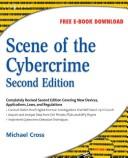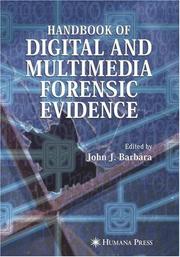| Listing 1 - 6 of 6 |
Sort by
|
Book
ISBN: 0769533620 1509078959 9781509078950 Year: 2008 Publisher: [Place of publication not identified] CPS Conference Pub Services
Abstract | Keywords | Export | Availability | Bookmark
 Loading...
Loading...Choose an application
- Reference Manager
- EndNote
- RefWorks (Direct export to RefWorks)
Digital forensic science --- Engineering & Applied Sciences --- Computer Science --- Computer and network forensics --- Computer forensics --- Digital forensics --- Network forensics --- Electronic evidence --- Forensic sciences --- Digital preservation
Book
ISBN: 0769531717 1509079467 9781509079469 Year: 2008 Publisher: [Place of publication not identified] IEEE Computer Society
Abstract | Keywords | Export | Availability | Bookmark
 Loading...
Loading...Choose an application
- Reference Manager
- EndNote
- RefWorks (Direct export to RefWorks)
Digital forensic science --- Forensic engineering --- Social Welfare & Social Work --- Social Sciences --- Criminology, Penology & Juvenile Delinquency --- Computer and network forensics --- Computer forensics --- Digital forensics --- Network forensics --- Electronic evidence --- Forensic sciences --- Digital preservation --- Engineering
Book
ISBN: 1281762954 9786611762957 0080560199 159749268X 9780080560199 9781597492683 9781281762955 6611762957 Year: 2008 Publisher: Burlington, MA : Syngress Publishing,
Abstract | Keywords | Export | Availability | Bookmark
 Loading...
Loading...Choose an application
- Reference Manager
- EndNote
- RefWorks (Direct export to RefWorks)
Malware Forensics: Investigating and Analyzing Malicious Code covers the emerging and evolving field of ""live forensics,"" where investigators examine a computer system to collect and preserve critical live data that may be lost if the system is shut down. Unlike other forensic texts that discuss ?live forensics? on a particular operating system, or in a generic context, this book emphasizes a live forensics and evidence collection methodology on both Windows and Linux operating systems in the context of identifying and capturing malicious code and evidence of its effect on the compromised
Computer security. --- Computer viruses --- Computer crimes --- Investigation. --- Computer forensics --- Cyber forensics --- Cyberforensics --- Internet forensics --- Criminal investigation --- Software viruses --- Viruses, Computer --- Malware (Computer software) --- Computer privacy --- Computer system security --- Computer systems --- Computers --- Cyber security --- Cybersecurity --- Electronic digital computers --- Protection of computer systems --- Security of computer systems --- Data protection --- Security systems --- Hacking --- Protection --- Security measures --- Information Technology --- General and Others

ISBN: 1281716871 9786611716875 0080486991 1597492760 9780080486994 9781597492768 9781281716873 6611716874 Year: 2008 Publisher: Burlington, MA : Syngress Pub.,
Abstract | Keywords | Export | Availability | Bookmark
 Loading...
Loading...Choose an application
- Reference Manager
- EndNote
- RefWorks (Direct export to RefWorks)
When it comes to computer crimes, the criminals got a big head start. But the law enforcement and IT security communities are now working diligently to develop the knowledge, skills, and tools to successfully investigate and prosecute Cybercrime cases. When the first edition of ""Scene of the Cybercrime"" published in 2002, it was one of the first books that educated IT security professionals and law enforcement how to fight Cybercrime. Over the past 5 years a great deal has changed in how computer crimes are perpetrated and subsequently investigated. Also, the IT security and law enforcement
Computer crimes --- Computer networks --- Computer security. --- Forensic sciences. --- Investigation. --- Security measures. --- Criminalistics --- Forensic science --- Science --- Criminal investigation --- Computer privacy --- Computer system security --- Computer systems --- Computers --- Cyber security --- Cybersecurity --- Electronic digital computers --- Protection of computer systems --- Security of computer systems --- Data protection --- Security systems --- Hacking --- Computer network security --- Network security, Computer --- Security of computer networks --- Computer security --- Computer forensics --- Cyber forensics --- Cyberforensics --- Internet forensics --- Protection --- Security measures --- Information Technology --- General and Others

ISBN: 1281148628 9786611148621 1597455776 1588297829 1617377759 Year: 2008 Publisher: Totowa, N.J. : Humana,
Abstract | Keywords | Export | Availability | Bookmark
 Loading...
Loading...Choose an application
- Reference Manager
- EndNote
- RefWorks (Direct export to RefWorks)
Handbook of Digital and Multimedia Forensic Evidence presents an overview of computer forensics perfect for beginners. This volume will serve as a foundation and guide for: (a) students considering a career in this field; (b) the law enforcement investigator assigned to work cybercrimes; (c) establishing training programs for forensic examiners; (d) the IT professional; (e) the veteran forensic examiner; (f) the prosecutor faced with litigating cybercrime cases brought before a trier of fact. A distinguished group of specialist authors have crafted chapters rich with detail yet accessible for readers who are not experts in the field. Tying together topics as diverse as applicable laws on search and seizure, investigating cybercrime, and preparation for courtroom tesitmony, Handbook of Digital and Multimedia Forensic Evidence is the ideal overall reference for this multi-faceted discipline.
Computer crimes --- Internet fraud. --- Evidence (Law) --- Criminal investigation. --- Investigation. --- Crime detection --- Crime investigation --- Criminal investigations --- Investigations --- Law enforcement --- Crime scenes --- Detectives --- Forensic sciences --- Extrinsic evidence --- Parol evidence --- Trial evidence --- Actions and defenses --- Judicial process --- Trial practice --- Estoppel --- Fraud --- Computer forensics --- Cyber forensics --- Cyberforensics --- Internet forensics --- Criminal investigation --- Criminology. --- Computers --- Forensic Medicine. --- Criminology and Criminal Justice, general. --- Legal Aspects of Computing. --- Law and legislation. --- Forensic medicine --- Injuries (Law) --- Jurisprudence, Medical --- Legal medicine --- Medicine --- Medical laws and legislation --- Cyberspace --- Crime --- Social sciences --- Criminals --- Law and legislation --- Study and teaching --- Computers. --- Forensic medicine. --- Automatic computers --- Automatic data processors --- Computer hardware --- Computing machines (Computers) --- Electronic brains --- Electronic calculating-machines --- Electronic computers --- Hardware, Computer --- Computer systems --- Cybernetics --- Machine theory --- Calculators
Book
ISBN: 0387849270 0387849262 Year: 2008 Publisher: New York, New York : Springer,
Abstract | Keywords | Export | Availability | Bookmark
 Loading...
Loading...Choose an application
- Reference Manager
- EndNote
- RefWorks (Direct export to RefWorks)
ADVANCES IN DIGITAL FORENSICS IV Edited by: Indrajit Ray and Sujeet Shenoi Digital forensics deals with the acquisition, preservation, examination, analysis and presentation of electronic evidence. Networked computing, wireless communications and portable electronic devices have expanded the role of digital forensics beyond traditional computer crime investigations. Practically every crime now involves some aspect of digital evidence; digital forensics provides the techniques and tools to articulate this evidence. Digital forensics also has myriad intelligence applications. Furthermore, it has a vital role in information assurance -- investigations of security breaches yield valuable information that can be used to design more secure systems. Advances in Digital Forensics IV describes original research results and innovative applications in the emerging discipline of digital forensics. In addition, it highlights some of the major technical and legal issues related to digital evidence and electronic crime investigations. The areas of coverage include: - Themes and Issues - Evidence Recovery - Evidence Integrity - Evidence Management - Forensic Techniques - Network Forensics - Portable Electronic Device Forensics - Event Data Recorder Forensics - Novel Investigation Techniques - Forensic Tools This book is the fourth volume in the annual series produced by the International Federation for Information Processing (IFIP) Working Group 11.9 on Digital Forensics, an international community of scientists, engineers and practitioners dedicated to advancing the state of the art of research and practice in digital forensics. The book contains a selection of twenty-eight edited papers from the Fourth Annual IFIP WG 11.9 Conference on Digital Forensics, held at Kyoto University, Kyoto, Japan in the spring of 2008. Advances in Digital Forensics IV is an important resource for researchers, faculty members and graduate students, as well as for practitioners and individuals engaged in research and development efforts for the law enforcement and intelligence communities. Indrajit Ray is an Associate Professor of Computer Science at Colorado State University, Fort Collins, Colorado, USA. Sujeet Shenoi is the F.P. Walter Professor of Computer Science and a principal with the Center for Information Security at the University of Tulsa, Tulsa, Oklahoma, USA.
Forensic sciences --- Electronics in criminal investigation --- Computer crimes --- Electronic discovery (Law) --- Evidence, Criminal --- Data processing --- Investigation --- Criminal evidence --- Criminal investigation --- Criminal procedure --- Evidence (Law) --- Reasonable doubt --- Computer discovery (Law) --- Cyber discovery (Law) --- Cyberdiscovery (Law) --- Digital discovery (Law) --- E-discovery (Law) --- Discovery (Law) --- Computers and crime --- Cyber crimes --- Cybercrimes --- Electronic crimes (Computer crimes) --- Internet crimes --- Crime --- Privacy, Right of --- Criminalistics --- Forensic science --- Science --- Information Technology --- Computer Science (Hardware & Networks) --- Computer science. --- Information systems. --- User Interfaces and Human Computer Interaction. --- Computer Science, general. --- Computers and Society. --- Computer Applications. --- Information Systems and Communication Service. --- Informatics --- User interfaces (Computer systems). --- Computers and civilization. --- Application software. --- Computers. --- Automatic computers --- Automatic data processors --- Computer hardware --- Computing machines (Computers) --- Electronic brains --- Electronic calculating-machines --- Electronic computers --- Hardware, Computer --- Computer systems --- Cybernetics --- Machine theory --- Calculators --- Cyberspace --- Application computer programs --- Application computer software --- Applications software --- Apps (Computer software) --- Computer software --- Civilization and computers --- Civilization --- Interfaces, User (Computer systems) --- Human-machine systems --- Human-computer interaction --- Digital forensic science --- Computer and network forensics --- Computer forensics --- Digital forensics --- Network forensics --- Electronic evidence --- Digital preservation
| Listing 1 - 6 of 6 |
Sort by
|

 Search
Search Feedback
Feedback About UniCat
About UniCat  Help
Help News
News